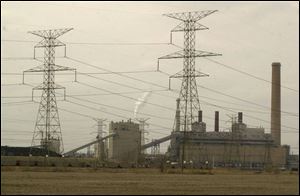
Mercury emissions ruling doesn't apply to coke plant
2/9/2008
The ruling may force FirstEnergy to invest in more pollution controls for its coal-burning Bay Shore plant in Oregon, Ohio.
FDS Coke Plant's proposed $800 million coking facility and co-generation power plant won't be affected by a federal appeals court ruling in Washington yesterday that invalidated the federal cap-and-trade system the Bush Administration had wanted for controlling mercury emissions.
But the decision could require millions of dollars more in pollution controls for Ohio's aging coal-fired power plants, including FirstEnergy Corp.'s Bay Shore facility in Oregon.
Trent Dougherty, staff attorney for the Ohio Environmental Council, called the court's ruling "a major victory for public health."
Coal-fired power plants are collectively the nation's largest source of airborne mercury, a neurotoxin that impairs childhood development.
It passes through mothers to fetuses.
Mercury also is the pollutant behind many consumption advisories for Great Lakes fish. As it settles into water, it forms methylmercury and becomes 1,000 times more potent than what's in the air, according to the U.S. Environmental Protection Agency.
Rather than enforce a section of the 1970 federal Clean Air Act that deals with it, the Bush Administration in 2005 created a separate mercury rule for coal and oil-fired power plants.
It proposed a "cap-and-trade" system that offered utili-ties the chance to buy and sell emission credits rather than be held to plant-specific work.
A similar program has been in place for sulfur dioxide, the main pollutant behind acid rain.
Critics accused the administration of creating a weaker rule to accommodate utilities that had helped fund President Bush's election campaigns.
FirstEnergy was among the largest of the utility contributors.
The U.S. EPA's inspector general said in 2005 that senior agency officials ordered staffers to work backward from a predetermined outcome of 34 tons of mercury a year "instead of basing the standard on an unbiased determination of what the top performing [power plant] units were achieving in practice."
Days later, the Government Accountability Office identified shortcomings in a cost-benefit analysis the U.S. EPA used to help craft the rule.
The nation's 1,100 power plants emit about 48 tons of mercury a year.
The rule was appealed by 14 states, plus several Native American tribes, public health groups, and environmental organizations.
Ohio wasn't one of them. The Ohio Environmental Protection Agency adopted rules that mirrored the Bush plan.
Linda Oros, Ohio EPA spokesman, said the state agency is reviewing its options in light of the ruling.
"Like it or not, Ohio's going to have to do more - not less - to protect the health and safety of people from its power plant emissions," Jack Shaner, a spokesman for the Ohio Environmental Council, said.
Utilities will wait to see what new control requirements are developed, Ralph DiNicola, a FirstEnergy spokesman, said.
"We all are kind of in the same boat," Mr. DiNicola said.
"We don't know what the reduction will be and when it will be required," he said.
The proposed FDS facility could join Bay Shore as a major mercury source in the Toledo area.
But it is not affected by the ruling because coke ovens were not included in the Bush Administration's proposed cap-and-trade system for mercury, said Lance Traves, FDS project manager and environmental consultant.
Contact Tom Henry at: thenry@theblade.com or 419-724-6079.